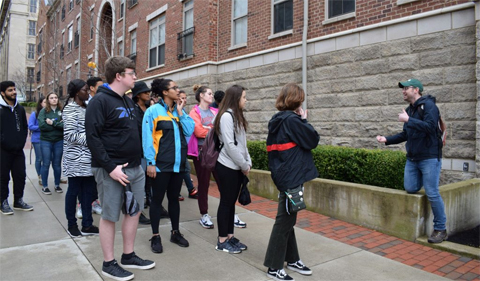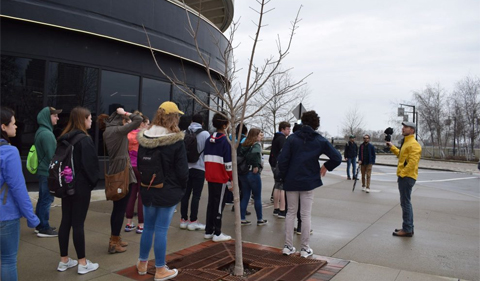
Kyle May, senior planner at planning NEXT in Columbus, explains students about the city’s ongoing building boom and resulting gentrification.
Dr. Yeong Kim took 22 students, mostly from her Urban Geography class, but also from Geography-Urban Planning and Sustainability, International Development Studies, and the Wealth and Poverty certificate, to Downtown Columbus on March 30 to investigate several redevelopment sites, including the Scioto Mile, Franklinton, Short North, and Arena District.
Although it rained heavily at times, the field trip team was able to meet with several urban planning experts who have been directly involved in a series of gentrification projects in the city’s older neighborhoods.
Columbus-based urban planner and Ohio University alumnus Kyle May ’09, senior planner with planning NEXT, arranged all the details of the field trip and scheduled a list of very impressive speakers who came to talk to OHIO students on a rainy Saturday about recent developments and investments in the city.
May earned a B.S. in Geography-Urban Planning from the College of Arts & Sciences at Ohio University.

Justin Goodwin, Transportation Planning Manager of The City of Columbus, briefs students about Columbus’s recent riverfront project, called the Scioto Mile.
When students arrived at City Building, they were greeted by several Columbus city government officials, including alumnus Justin Goodwin, who earned a B.S. in Geography from the Honors Tutorial College (2002) and an M.A. in Geography from the College of Arts & Sciences (2005).
The field trip started with a PowerPoint presentation, given by Mark Dravillas, assistant administrator of the Planning Division of the Development Department, and Scott Ulrich, Health Places program director of the Public Health Department, as well as Goodwin, Transportation Planning Manager of the Public Service Department, to overview some of the recent developments Columbus has undergone to meet the growing demand for office space and apartments in the downtown area.
After a series of questions and answers between students and the government officials about the city’s long-term and short-term planning goals, Goodwin and Ulrich led the group to a walk along Columbus Commons and the Scioto Mile, focusing on the city’s effort to expand green public space and healthy places for local residents. Once the group crossed the Scioto River, they could see a mix of old rundown buildings and brand-new artistic postmodern architecture in Franklinton. Local developer Blake Compton of Compton Construction gave an informational tour highlighting Franklinton’s transition from an old floodplain into a hot development site filled with new public infrastructure projects, creative artist spaces, affordable homes, and private land developments.
Given that the field trip was about the redevelopment of Downtown Columbus, it was fitting to have lunch at the North Market that has played a key role in attracting both residents and tourists back to the city center. After lunch, students were divided into two groups: those who would like to see the Short North Arts District and those to see the Arena District. While Betsy Pandora, the Executive Director of the Short North Business Association, led the former group, Chris Hermann of MKSK Studios led the latter group. They both showed students around how these recently redeveloped areas were able to attract businesses and what the city government did, or failed to do, to retain the existing businesses and residents.
Allison Shryock (Junior in HTC Geography and Environmental Studies) reflects on her field trip to Columbus, with particular focus on the impact of gentrification on low-income residents and business owners:
We first visited the Scioto Mile, an area that functions as a central community gathering point. This green space is great for outdoor activities in the summer and is a place where people of different backgrounds can come together. Since the river occasionally floods, native plants were selected to be planted along the river. Overall, this area provides green space in the center of the city where people can gather and partake in recreational activities. Next, we walked to Franklinton, a neighborhood that is now connected to downtown by a bridge. This area is starting to regain interest due to a flood wall that was built, making it safe for redevelopment. The planners addressed the question of gentrification by saying that this area was underdeveloped and had high amounts of vacancies. This question arose after we were shown a new apartment building that replaced an affordable housing complex. One of the main construction companies working on this neighborhood is Compton Construction, owned and operated by Blake Compton. His company has built a makerspace, which functions as a community center. The planners also stressed the importance of local artists in the new construction in the city. Gravity, another new apartment complex in the area, has attracted the attention of a nationally known artist, but also has incorporated local art.
Our group then had lunch at North Market, which is a great spot for locals to purchase local food. We then had the choice to visit the Arena District or Short North. I chose to go with the group that visited Short North. This part of the city used to be called Flytown and was a dangerous area. Now, it is a pioneer in urban revitalization. 300 businesses are located here, and it is known for its gallery hops. It also has numerous temporary murals that are frequently changed. As I was walking down the street, I noticed all of the coffee shops, boutiques and restaurants that are drawing people into the area. Since continued growth is expected in this area, the question of gentrification was brought up again. According to some of the planners, the city is now required to include a certain amount of public and affordable housing in new construction. However, it is too late for most new constructions to include this in the Short North area. While these new projects are bringing in more visitors, it is important to not exclude the people who are originally from the area. It is important to consider if it is worth it to push previous residents out in order to build a trendy, new area.
Overall, Columbus is an area that will continue to grow in the future, but city planners will be faced with the challenges of building adequate public housing, maintaining affordable rent and deciding if they want to build the city up or add to urban sprawl. It is important that the city planners collaborate with the local communities and listen to their needs.



















Comments